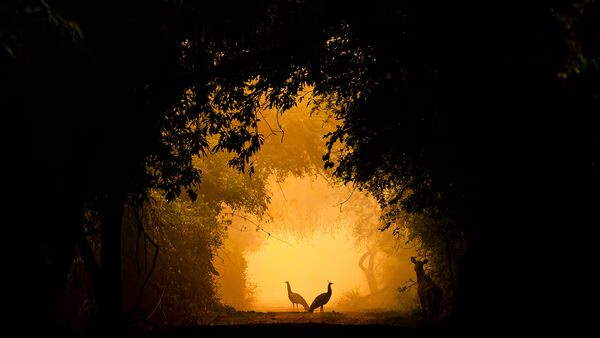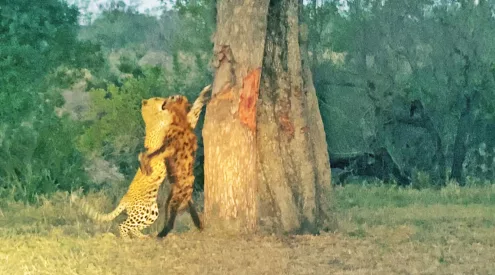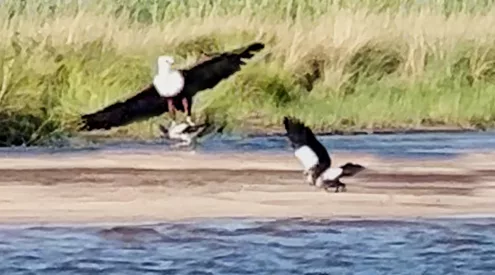After we had spent an extravagant amount of time with two golden-maned lions and their dangerously bloated buffalo carcass on the banks of the Linyanti swamps, we switched off our radar for a second epic wildlife sighting. How could we expect to bump into an African rock python eating its prey? That’s just it – you can never know what’s around the next bend in the wild world of Botswana.

Photo by Chloe Cooper.
There had been elephants, a mixture of vulture species, marabou storks, and the pair of gluttonous lions lazing on the green, sodden grass, and we had enjoyed an exclusive sighting with only the presence of Camp Linyanti’s Land Cruiser to accompany us. Photographer Kevin MacLaughlin and I left the sighting to drive through Chobe’s gorgeous Linyanti concession with an excellent game drive under our belts. My tired eyes caught sight of something dark and coil-shaped on the slopes of a bare termite mound and my delayed exclamation of “snake!” got Kevin’s attention.
We turned off the engine and listened to the chaotic chatter of birds and squirrels, alerting the world to the presence of the predator. A young African rock python was in the final stages of constricting its prey – we couldn’t believe what an incredible opportunity this was to witness such a wild act of nature. A squirrel had descended halfway down a tree just next to the snake and was barking angrily at it. We identified the prey as a water mongoose.

The python continued to curl itself around its prey before starting to eat. Photo by Kevin MacLaughlin.
The first rains had hit Botswana while we were journeying through the beautiful country, and we were lucky enough to feel the relief of a thunderstorm in the Okavango Delta. By the time we got to Linyanti rainfall had dampened the earth slightly, and with October being ‘suicide month’ in Botswana, we were feeling the humidity. African rock pythons, nicknamed ‘Afrocks’ by herpetologists, remain dormant during the dry season, and only need to feed once a year if their last meal was big enough. It is possible that we caught this python on its first hunt of the season, making the sighting even more remarkable.

Once the animal was dead, the predator began to consume it, head first. Photo by Kevin MacLaughlin.

The python has teeth at the back of its mouth that point inwards, helping to grip the prey once it has caught it. Photo by Kevin MacLaughlin.
Although the southern subspecies is generally smaller than those found further north in Africa, the African rock python is the largest on the continent and one of the largest snake species in the world. Growing to an astounding six metres in some cases, pythons are feared by humans; however, there is an exceptionally low rate of human attacks. Feeding mainly on rodents, monkeys, warthogs, and small antelope in the wild, pythons constrict their prey causing cardiac arrest, and then proceed to swallow it whole. We were close enough to see the python’s throat swell with each gulp.
On this memorable day at Camp Linyanti, we were privileged enough to watch the rare event right up until the end when the full-bellied snake crept silently into its hole in the termite mound. Its smooth, pale belly scales differentiate its underside from the mottled pattern of black and brown on its head, back and sides.

The final stages of feeding sees the tail end of the prey disappearing into the python’s throat. Photo by Kevin MacLaughlin.

After the python had finished its last mouthful it wasted no time in slithering back into its hole in the ground where it will undoubtedly stay to digest its meal.
Armed with both video and photographic equipment, Kevin managed to capture this incredible sequence of events at the base of the giant Linyanti trees. Enjoy the footage here:






















